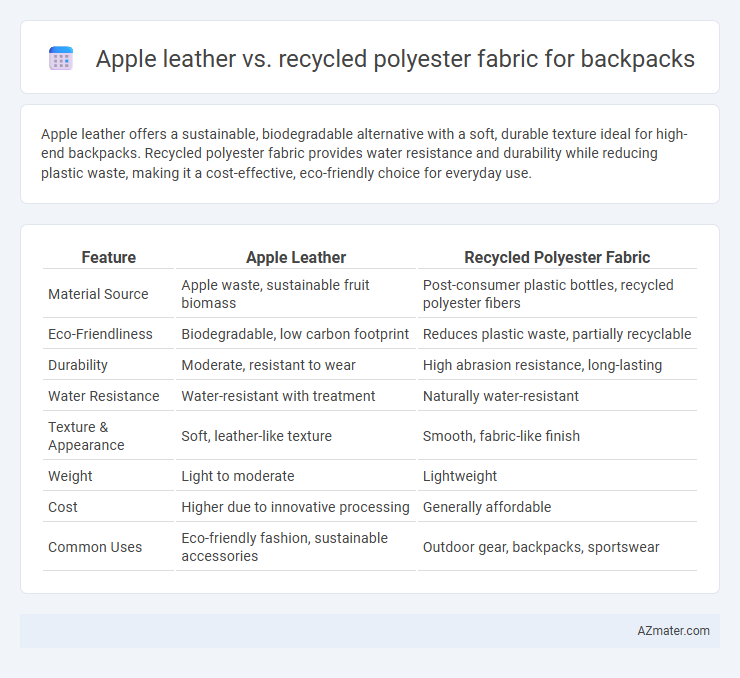Apple leather offers a sustainable, biodegradable alternative with a soft, durable texture ideal for high-end backpacks. Recycled polyester fabric provides water resistance and durability while reducing plastic waste, making it a cost-effective, eco-friendly choice for everyday use.
Table of Comparison
| Feature | Apple Leather | Recycled Polyester Fabric |
|---|---|---|
| Material Source | Apple waste, sustainable fruit biomass | Post-consumer plastic bottles, recycled polyester fibers |
| Eco-Friendliness | Biodegradable, low carbon footprint | Reduces plastic waste, partially recyclable |
| Durability | Moderate, resistant to wear | High abrasion resistance, long-lasting |
| Water Resistance | Water-resistant with treatment | Naturally water-resistant |
| Texture & Appearance | Soft, leather-like texture | Smooth, fabric-like finish |
| Weight | Light to moderate | Lightweight |
| Cost | Higher due to innovative processing | Generally affordable |
| Common Uses | Eco-friendly fashion, sustainable accessories | Outdoor gear, backpacks, sportswear |
Introduction: Choosing Sustainable Backpack Materials
Apple leather offers a biodegradable alternative crafted from apple peel waste, reducing reliance on animal leather and supporting circular fashion. Recycled polyester fabric utilizes post-consumer plastic bottles, transforming waste into durable, water-resistant material with a lower carbon footprint compared to virgin polyester. Both materials provide eco-friendly options for backpacks, balancing sustainability with performance and style.
What is Apple Leather?
Apple leather is an innovative, sustainable material crafted from the byproducts of apple juice and compote production, primarily apple peels and cores, that undergo a drying and grinding process to form a leather-like substrate. This plant-based alternative offers durability and a soft texture, reducing reliance on animal leather and petroleum-based materials often found in backpacks. Apple leather provides eco-friendly benefits by utilizing food waste and emitting fewer greenhouse gases during production compared to traditional leather or synthetic options like recycled polyester fabric.
What is Recycled Polyester Fabric?
Recycled polyester fabric is made from post-consumer plastic waste, such as discarded PET bottles, which are cleaned, melted, and spun into new fibers, significantly reducing landfill waste and environmental impact. This sustainable material offers durability, water resistance, and lightweight properties, making it ideal for backpacks that require strength and versatility. Unlike Apple leather, which is derived from apple waste and mimics animal leather, recycled polyester prioritizes the use of plastic materials, contributing to resource circularity in the textile industry.
Production Process: Apple Leather vs Recycled Polyester
Apple leather, produced from apple waste by drying and blending apple peels and cores with polyurethane, offers an eco-friendly alternative by repurposing agricultural byproducts and reducing landfill waste. Recycled polyester fabric is made from post-consumer plastic bottles that undergo melting and reforming into fibers, significantly lowering reliance on virgin petroleum and decreasing plastic pollution. The production of apple leather tends to have a lower carbon footprint and biodegrades more easily, while recycled polyester fabric excels in durability and water resistance but can shed microplastics during washing.
Environmental Impact Comparison
Apple leather, made from apple peel waste, offers a biodegradable and renewable alternative with a lower carbon footprint compared to traditional materials. Recycled polyester fabric, derived from post-consumer plastic bottles, reduces landfill waste and energy use but contributes microplastics during washing and has limited biodegradability. Both materials support sustainable fashion, but apple leather provides superior environmental benefits in terms of end-of-life decomposition and resource renewability.
Durability and Performance
Apple leather offers exceptional durability with a natural resistance to wear and tear, maintaining its structure while providing a lightweight feel ideal for backpacks. Recycled polyester fabric excels in abrasion resistance and water repellency, enhancing backpack performance in various weather conditions. Both materials deliver eco-friendly benefits, but apple leather boasts superior longevity and a premium texture, while recycled polyester prioritizes moisture management and durability.
Aesthetics and Design Flexibility
Apple leather offers a premium, natural look with a smooth texture that enhances the luxury appeal of backpacks, while recycled polyester fabric provides versatile design options with its wide range of colors and patterns. The vegetable-tanned quality of apple leather allows for elegant finishes and subtle variations that age beautifully, contrasting with the synthetic resilience and customization flexibility of recycled polyester. Both materials support sustainable design, but apple leather excels in sophisticated aesthetics, whereas recycled polyester maximizes creative freedom and functional detailing.
Cost Analysis: Which is More Affordable?
Apple leather tends to cost more than recycled polyester fabric due to its sustainable production process involving agricultural waste and less established manufacturing scales. Recycled polyester is generally more affordable because it uses post-consumer plastic bottles and benefits from widespread industrial recycling infrastructure. When comparing backpacks, recycled polyester offers cost efficiency for budget-conscious consumers, while apple leather commands a premium for eco-friendly luxury.
Consumer Preferences and Trends
Consumers increasingly favor Apple leather for backpacks due to its sustainable origins from apple waste, appealing to eco-conscious buyers seeking cruelty-free alternatives. Recycled polyester fabric remains popular for its durability and affordability, attracting consumers prioritizing performance and budget. Market trends indicate a growing demand for innovative, sustainable materials that balance environmental benefits with functionality in everyday use.
Conclusion: Which Material is Best for Backpacks?
Apple leather offers a sustainable, biodegradable alternative with a unique texture and natural breathability, ideal for eco-conscious backpack users seeking durability and style. Recycled polyester fabric provides exceptional water resistance, lightweight strength, and easy maintenance, making it a practical choice for high-performance backpacks. The best material depends on the user's priorities: choose apple leather for eco-friendly aesthetics and recycled polyester for rugged, weatherproof functionality.

Infographic: Apple leather vs Recycled polyester fabric for Backpack
 azmater.com
azmater.com